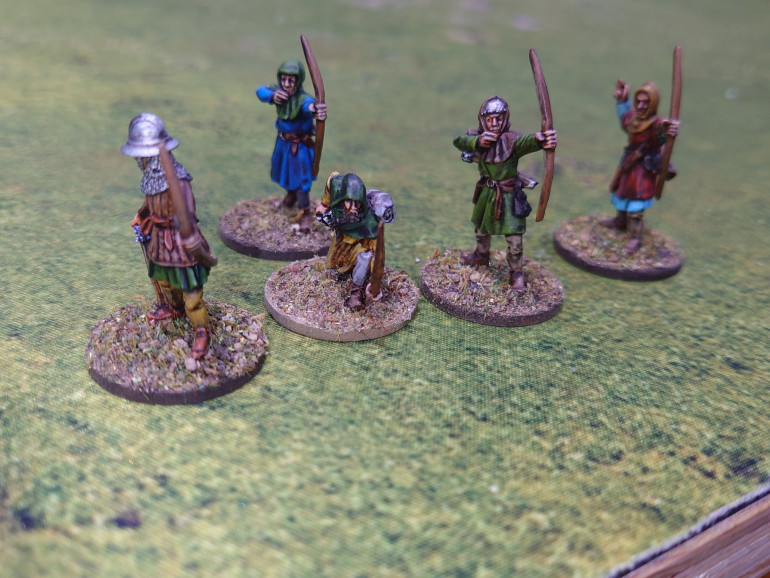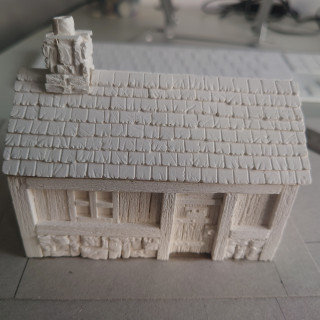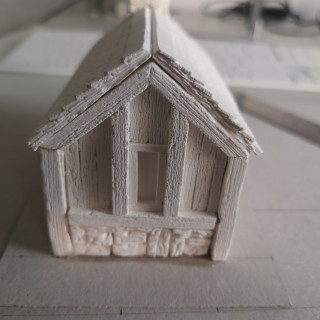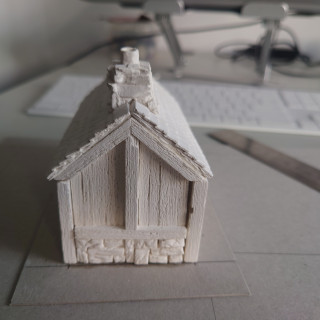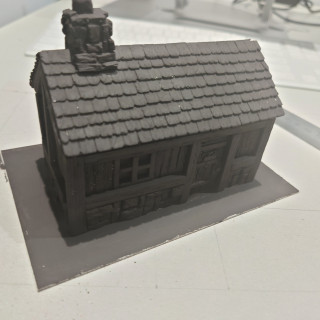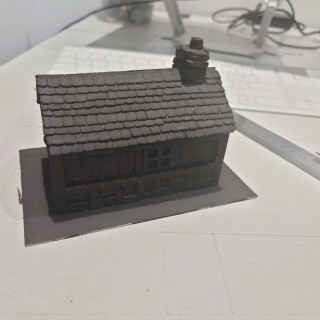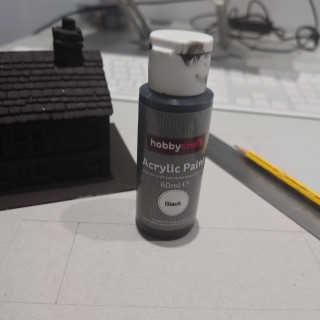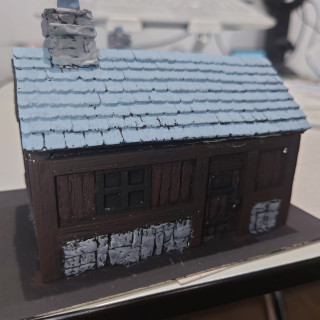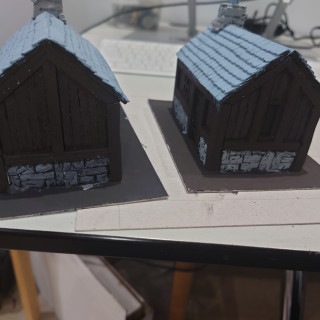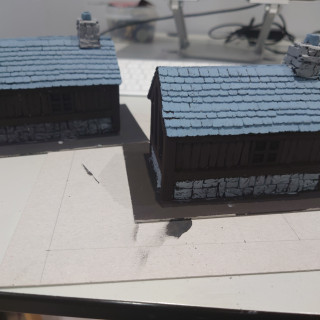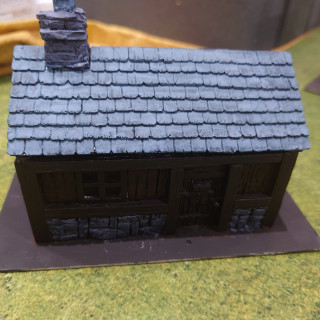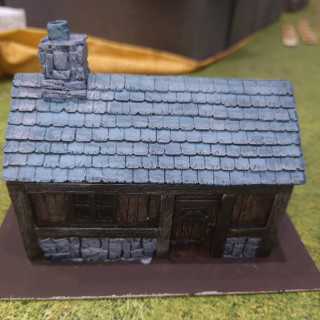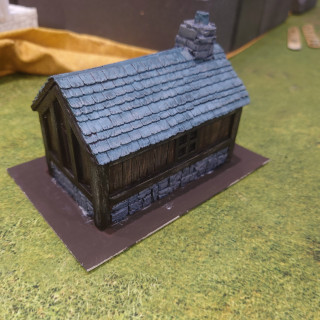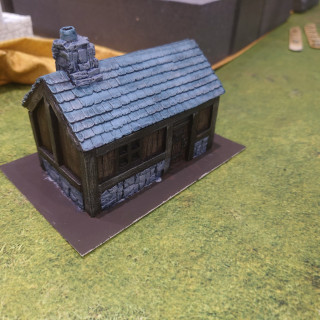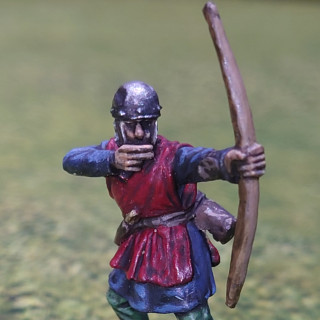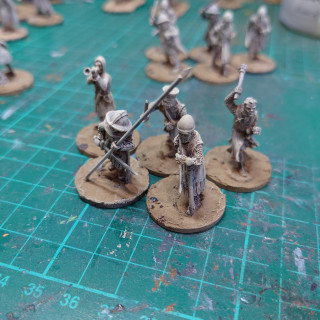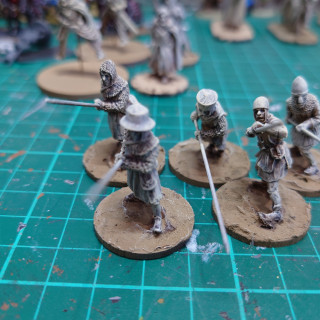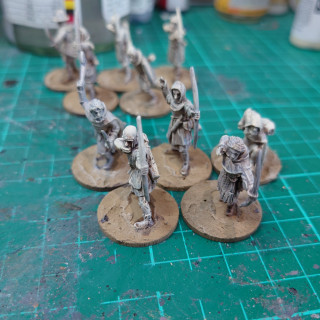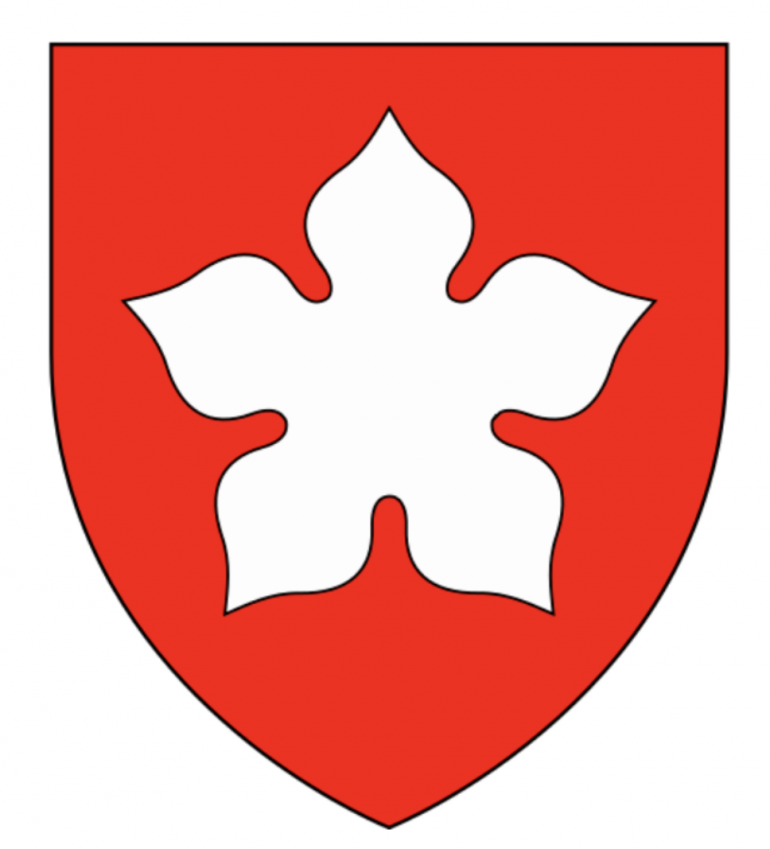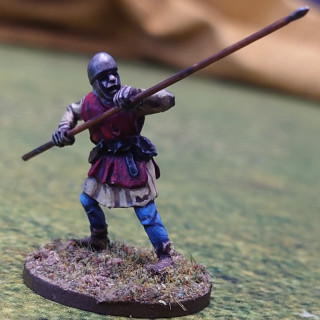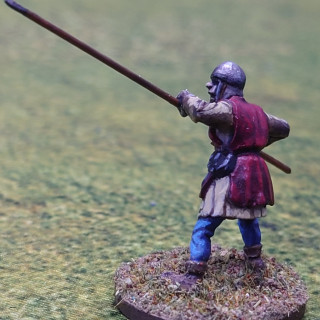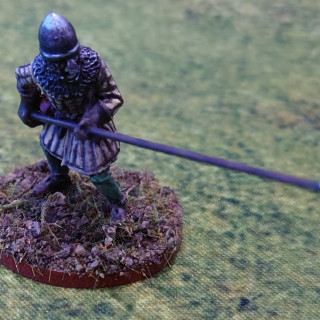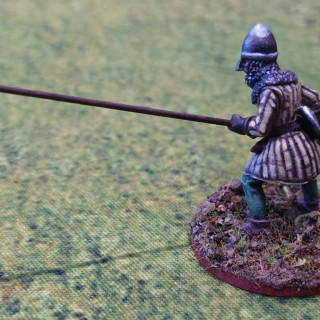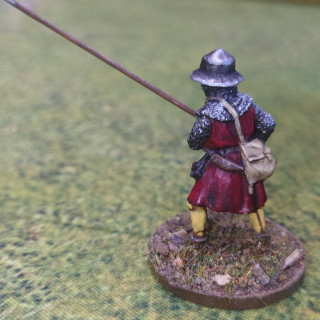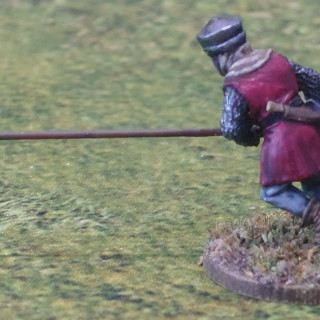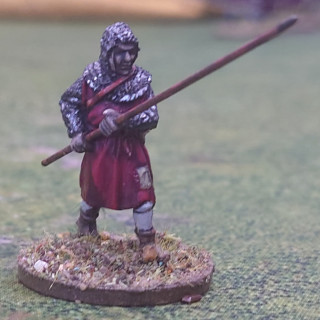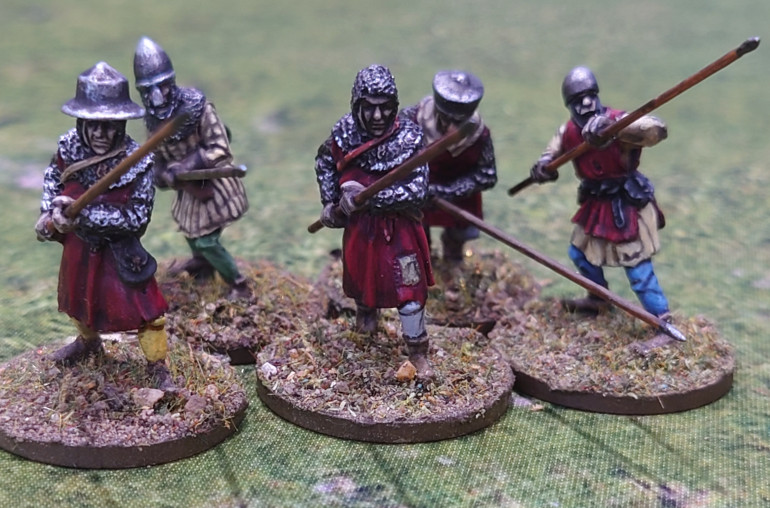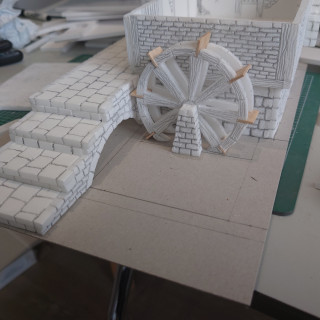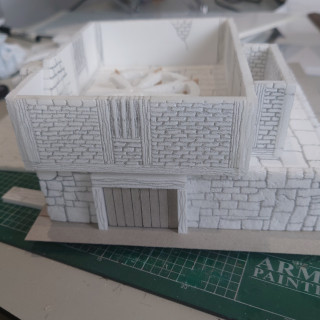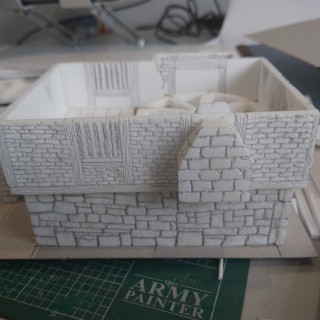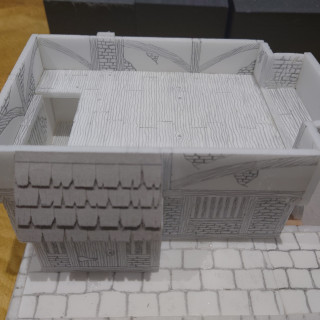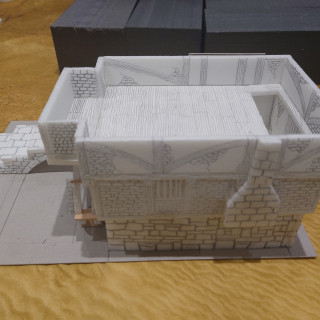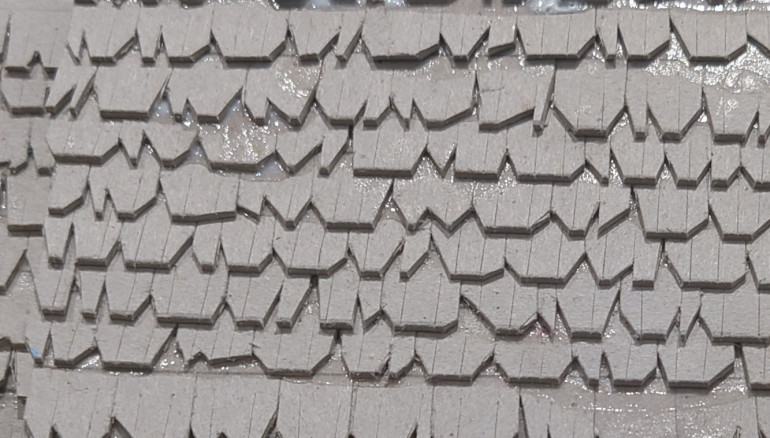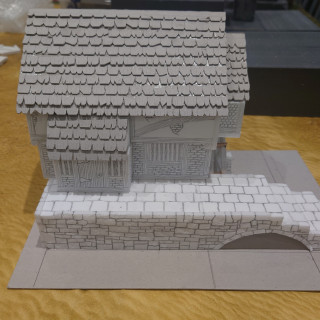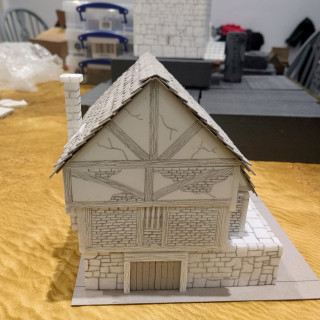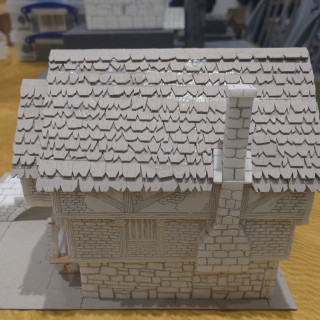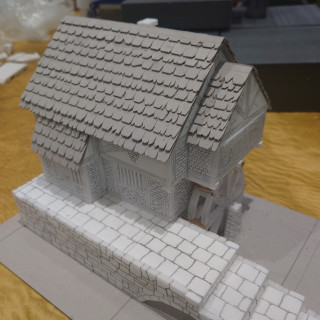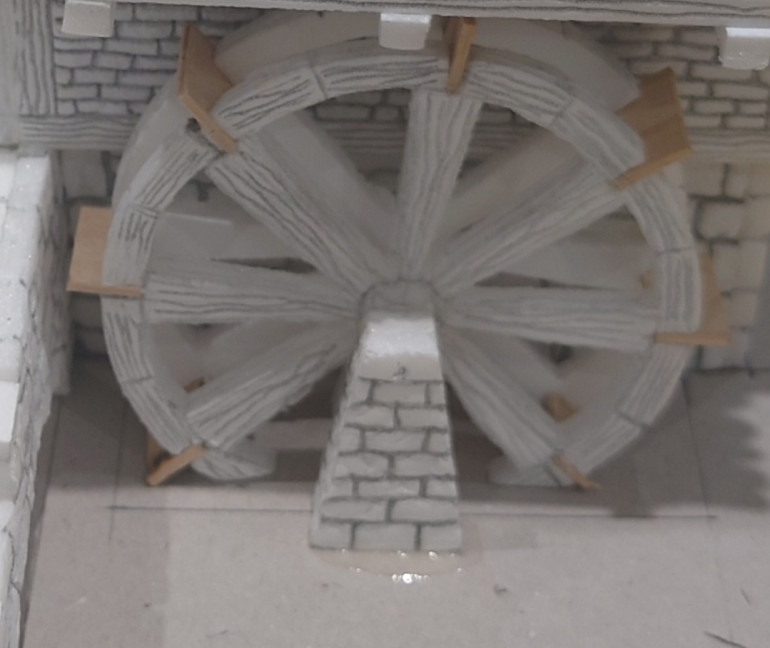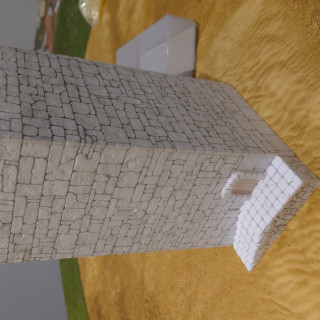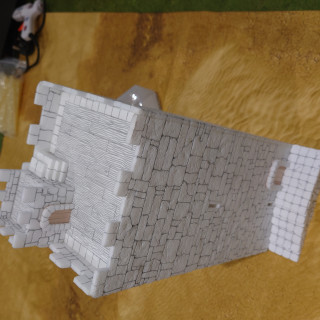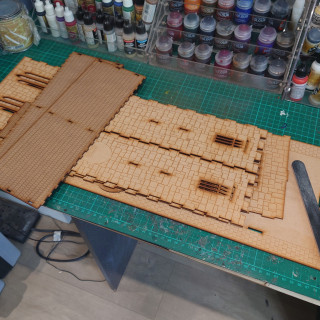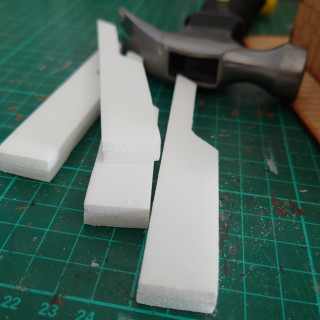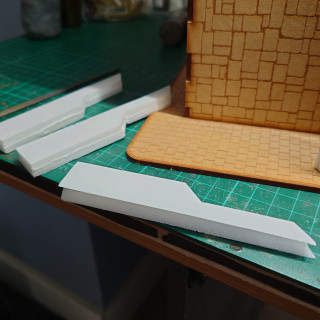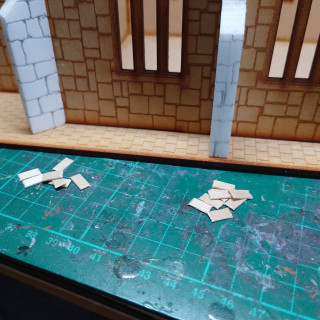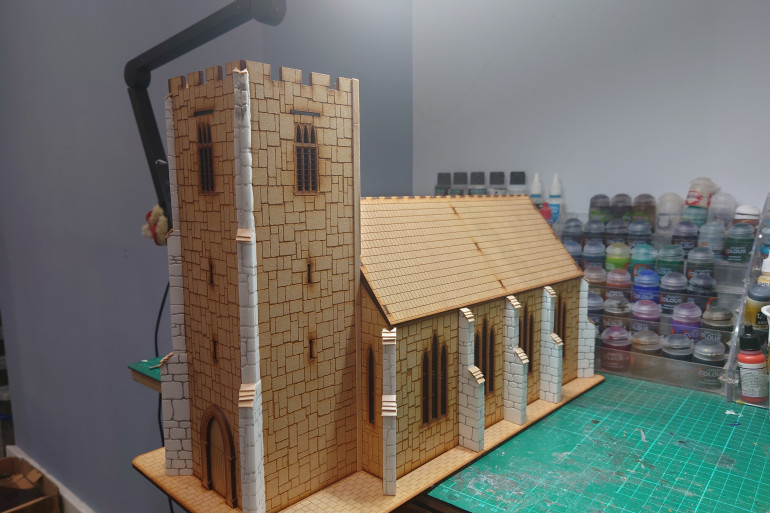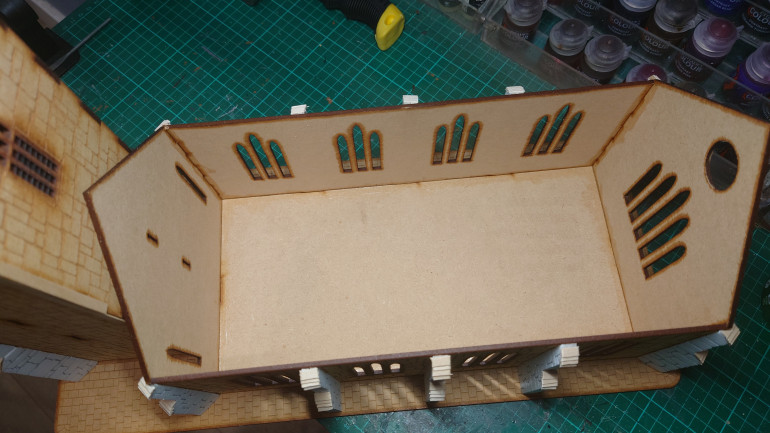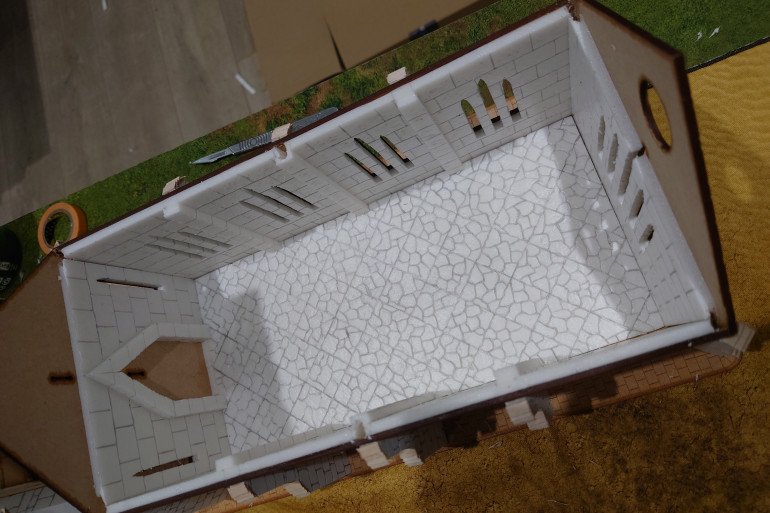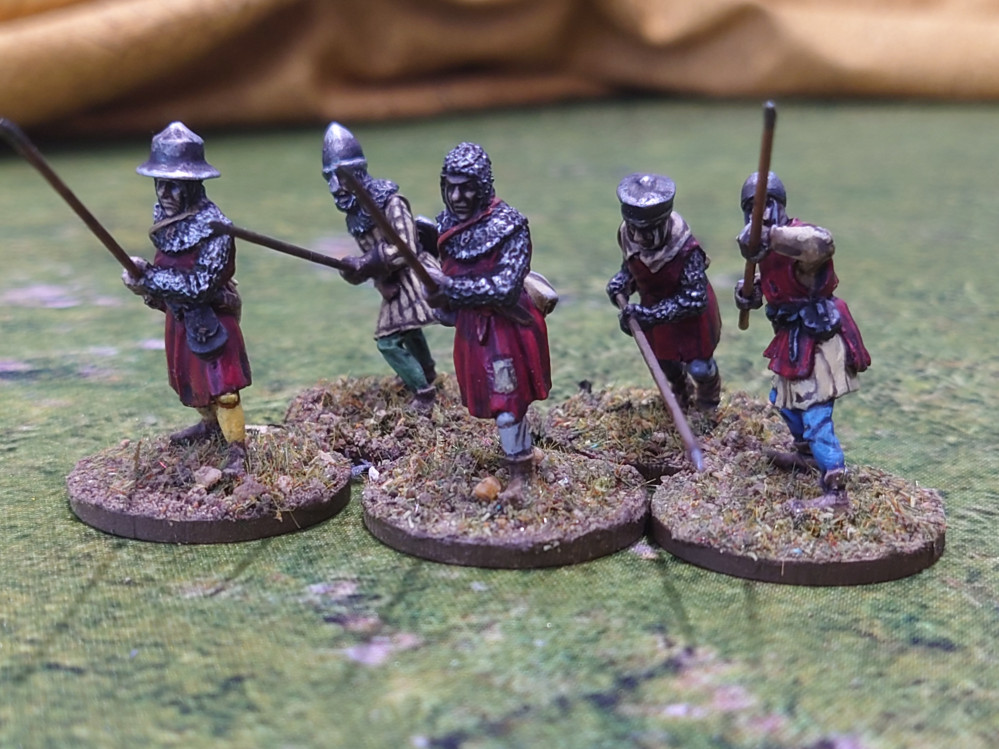
Medieval Mayhem – A Barons War Project
Recommendations: 172
About the Project
This project is about my journey into The Barons War, a game published by Footsore Miniatures. It will be a project I will add to over time as I add more to the game.
Related Game: The Barons' War
Related Company: Footsore Miniatures and Games
Related Genre: Historical
This Project is Active
Arrows of outrageous fortune
The next figures I have been working on are my archers.
These have been done in an assortment of colours as uniforms not really being a thing for all troops. Plus it means I can use them as wolfsheads should I need to.
Terrain - the cottage
No not the Fulham football ground, but more buildings for my barons war. I have returned from my Transatlantic sojourn and have started to re connect with the hobby vibe. I am still somewhat jet lagged so it’s simple operations to start with.
I ordered two medieval cottages from fleabay and they were very traditional plaster of Paris constructions each with four walls, two roof sections and a chimney stack.
I actually built these before my trip and u fortunately I failed to take any pictures of the pre constructed buildings.
Preparation
These came as mentioned in multiple parts, which were designed to slot together easily. However like many plaster casts they had gone a bit wrong in the casting with the wall sections needing to have the slots recut. This I did with the use of a mini saw blade and a scalpel knife. It was a relatively quick process, to tidy up.
Construction
So the next step was construction. I decided that I would create bases for the cottages and I used some of my card stock.
The next stage was to get the UHU glue out and glue everything together and wait for them to set. I then had two built cottages in a relatively quick space if time.
Painting
To paint the cottages I first used some cheap black paint from Hobbycraft to provide a primer.
After the primer coat I mixed in some brown with the remaining black to base coat all the wooden areas. After that I mixed up some grey paint and painted the stone work with a wet brush so that some of the black primer showed through.
The next stage was to add some blue to the grey so that I could base coat the roof tiles.
Then I began highlighting the wood having added some cream colour to the base coat of the wood. I then started to lighten up the wood panels.
I then started to lighten up the wood panels. Once the panels had been lightened. I then used a number of contrast paints.
- The roof – gryph charger grey
- The stone walls – space wolf grey
- The wood panels – gore grunta fur
- The support beams and posts – cygor brown
Then to finish the buildings I used a Vallejo cold grey to dry brush the roof, and the stone work.
I used Vallejo light brown to dry brush the wooden panels.
Then a mixture of cold grey and light brown on the beams and the posts.
Miniatures - Archers
After I completed the Spearmen it was on to the Archers. There are two units if archers in the retinue pack I purchased from Footsore. These each are of 5 models each.
Like the Spearmen they were prepared in exactly the same way.
The colour scheme for the archers will be following that of the Spearmen as they are all from the same retinue. So basic colours for their clothes and a reddish tabard or surcoat.
The first archer has come out well I think, only 9 more to do ?
Miniatures
Preparation of the Miniatures
My first Miniatures purchase for TBW was the chosen men retinue, and a couple of mounted figures.
The first stage was to ensure that all the figures were prepared correctly. The usual method of removing excess metal and mold lines where possible.
The figures were then washed in water and dish soap and left to dry.
The next step was to glue them onto the round biscuit bases that were provided. Then I used Vallejo Grey earth texture around the base of the miniature I don’t cover the metal base it is just to avoid a lip.
The painting process started by spraying the figures with Zandri Dust from GW.
I then washed the Miniatures in Agrax Earth shade.
- Then dry brushed with sand yellow from Vallejo, and then pale sand also from Vallejo.
Spearmen
The first unit I worked on was the Spearmen. I decided to tie them together as part of a retinue by choosing the arms of the lord which will be red with a white cinquefoil.
The Spearmen come with Separate white metal spears , but these are pretty bendy so I decided to replace them. I could purchase separate spears. But I have a lot of brass rod. Therefore made my own I cut the brass rod I t lengths of around 6cm. I then used pliers to flatten the ends and a jewelers file to create the points. I then drilled out the hands of each spearman using a pin vice.
Painting was then started.
Terrain - Water Mill
Now that I had experimented with terrain building in 28mm and realised it was actually a matter of measuring and building out standard shapes I was ready to try something a little bit more ambitious. So looking around at items if terrain I have in other scales I decided to take inspiration from the watermill I have from the Joan of Arc game from Mythic games.
However first up was to decide how to base it and that required looking at my river sections that I have. So I then took a piece of A4 grey card and measured out the river and where the mill would sit.
The next decision was should I build this in a solid building or so I could create levels. I decided on level as that gave me the following advantages.
- It would be easier to build
- I could use the measurements of the previous layer to build the next layer out.
- It would be more robust
- I could use it for DnD as well.
So the first level was to build the stone base and the bridge over the river and the water wheel.
Then I moved onto the main level of the mill which I glued directly onto the the base level.
The other thing I needed to do was to consider the design of the interior and as such not only mark out the floors and the walls using pencil, but also the idea of what a mill was like inside so I created a section where a shaft would go through the floor to connect with the wheel. ( although I decided to not do the interior workings at this time as that would be an issue for future me. But I did create the fire place and windows.
The next level required a bit more thought as it had to line up with the lower level and be able to slot over it. Plus it had to have a roof for the entrance.
This was constructed in much the same way as the previous level. I started with a piece of foam core as the floor then measured out the walls. The only difference was that I off set created a lip to slot over the lower level. This proved to be a bit tricky as so ended up cutting the lip so there were tabs in strategic places. This has replicated beams sticking out of the building as supports.
I also cut out a section where I could add a set of stairs or mor likely a ladder so access can gained to the top floor.
Next up was the roof section. This I knew would be required a sloping tiled roof. But only needed two end sections so would require a bracer between the end sections.. this proved to be tricky getting the measurements correct, but in the end it worked out and then I could start on the roof.
As it is a sloped roof I cut a section of card to the the size of both roof sides. Then scored it so it would bend in the middle. I then glued this to the previous structure. To create a base.
Tiles
- Then it was onto the most tedious part of the roof, doing the tiles. There are generally two methods. Create each tile individually or do them in strips. I opted to do them in strips. The reason for this was that it would be easier to add.
Terrain - Castle
After creating the buttresses in the Church ( see previous entries) I thought what else could I do with my remaining foam core. Every medieval setting needs some form of castle. Plus I had been meaning to create a tower for Dungeons and Dragons so of course it was a easy decision. So I decided to create a square tower.
Unfortunately I did get a bit carried away and didn’t take any pictures of the build process. But it basically went like this.
- Step one decide on the size, I used the height of the church tower as a rough guide.
- Cut out the four sides
- Create the roof section.
- Soak off the paper from the foam core ( this is a really horrible task and would not recommend it in anyway buy foam core without paper).
- Using a pencil creat the brick and wood textures.
- Build the main box and use interior bracing supports to give extra strength. Also masking tape to hold the pieces together as the PVA sets don’t try and use super glue that messes up the foam core.
- Realise you need a door
- Construct steps and add a door using coffee stirrers.
- Decide that there needs to be a way of getting to the roof of the castle tower so build a mini tower in the corner and add a door.
Terrain - Church
Barons war requires that you have a decent amount of terrain. I realised that I have very little in the way of anything in 28mm. Then I recalled buying a Medieval Church MDF kit some years ago. So after some rummaging around I found it and started to build it
When I had built the kit I realised it was lacking something, it took me a while before I realised it was missing buttresses. So that got me thinking how do I create these. Then I remembered that I had some foam core hanging around. So decided to make them out of that.
I then proceeded to use a pencil to create the stone work, before using PVA glue to stick the foam core to the MDF. The last bit of detail was to add tiles using coffee stirrers to the buttresses.
That then completed the outside of the church, I was really pleased with how it looked.
However, that then lead me to consider the interior of the Church. It’s what you might call sparse with details.
So after ordering more foam core sheets, this time with no paper covering. I created the churches interior using 5 panels. One for each wall and one for the floor. These required a bit more work then the buttresses, and I used a scrunched up ball of kitchen foil to add texture. I also added interior brick work to the roof of the church tower.
The Earl of Bedfordshire
The campaign
The main outline of the campaign will be to have the players compete to earn enough prestige to become the Earl of Bedfordshire ( a fictional title).
This section will grow as I think of more things and add to it.
Players
Each player will take the role of a landed knight. To divide the county up I have used an old map of Bedfordshire which is divided into hundreds.
Each player will be allocated a Hundred to be their territory.
Each player will be able to locate two villages within their territory. This will be done ahead of the campaign day start. by each player without knowing where the other players will locate their villages.
As GM I will reveal the final map on the day if the campaign.
Maps
As described above each player will be allocated a portion of land to be theirs. I have generated a hex map of Bedfordshire, which I will publish on here after the event. Just to keep any players who may see this in the dark.
Campaign format
The aim if the campaign is to play out over either one or two day long sessions with each game turn lasting 1 hour.
This will be divided into
15 mins – for campaign moves and purchases if buildings and training soldiers etc
45 mins – for battles to take place. This is one of the reasons why I wanted to use barons war as games can be quick. It is also the reason I want to prepare the players with intro games.
Creating forces
Each Lord will have a starting retinue of approximately 500 points. Although I will be translating the points into upkeep costs. So each player will have decisions to make.
In addition they will have to develop their territory to ensure they can generate enough income to sustain their retinues.
Territory
Each player will be able to manage their lands by adding features that will generate income and man power which they will need to build their forces. To capture nearby settlements etc.
Developments
Examples of developments are going to be.
- Farms – crops and animals
- Religious – Churches, abbey’s and monestaries
- Village – blacksmith, bakery, tanners, fletchers, houses etc
- Castles – these will be limited to one per lord. But will be small , medium and large.
External Forces
In medieval society there were other forces at work besides the local lords.
These will come in the form of Church and State, both very powerful.
At a local level these will be represented by the following powers
- The Bishop – who will be doing god’s work of controlling all the church income in the form of tithes and issuing punishment for evil doers with the worse being excommunication or sending lord’s off on a crusade.
- The Sheriff – who will be enforcing the kings will and be responsible for collection of Taxes and issuing permissions to build castles etc
Other forces that will come into play are the roving band of Outlaws who will be ever willing to steal from the rich and give to the poor. The outlaws will of course be supplemented with and desertions from the forces of a lord who fails to pay his retinue or has to disband his troops due to lack of income.
From small acorns mighty oaks may grow... Or in this case an obsession can develop.
Over the last year or so I have been getting more and more interested in Medieval history. I have been listening to audiobooks, acquiring books on various armies of the medieval period. This started with the building of a 15mm Portuguese army for Mortem et Gloriam, which was followed by a trip to Portugal and a guided tour of some of the Templar sights.
Anyway it got me thinking I would like to do a campaign for our gaming club. I started off thinking about using MeG but then I decided I wanted something a bit more low level. I wanted to set the campaign in our county of Bedfordshire. I wanted to be able to get several games in a single session of the club. So it quickly became clear I needed a set of rules that could be a bit more skirmish like.
Looking around there were two options that suited what I was looking for. This was Lion Rampant and The Barons War I ordered both sets to read and decide on which to choose.
Lion Rampant – the medieval version of the Rampant rules series from Osprey. I have played other variants such as Xenos Rampant and Pikemans Lament. The pros of this were they were easy to play and everyone at the club would enjoy. The cons they didn’t quite have the flavour I wanted feeling a bit too generic and there would be the tendancy to want to creep into chunky units.
The Barons War – these were a new set of rules to me and specifically designed for the period I am interested in playing. The pros are that they seem to be a bit more flavoursome, with almost a movie style. They played with small units and quite fast. The cons are they are slightly more complex and I would need to teach my club mates how to play.
After some deliberation and a play test of Barons War I decided that these would be the rules I would use.
Action Plan
I am actually creating this project sat in sunny Florida on vacation with a cocktail by the pool…it’s a hard life but hey sometimes you got to relax away from life.
Stil as much as I am getting away from things I am getting hobby withdrawal so that is why I am creating this blog..lol
Anyway the barons war action plan I have decided that this will be split into three types of entry.
- The gaming in which I will plan the games/ campaigns of Barons War
- The Miniatures – discussing the Miniatures I paint and why I have chosen them.
- Terrain – Barons war requires lots of terrain and I do enjoy a bit of terrain making.
The order of what I plan to do in terms of getting my club involved. Is to start small with introduction games. Before running a campaign at the club hopefully later on this year, or early next year.
Terrain Ideas
So far I have a Church, a Castle and water mill. I also have a couple of houses that were precast out if plaster.
But going forward I am thinking of creating the following buildings
- Blacksmith
- Inn or Tavern or both
- Barn
- Farmhouse
- Bakery
- Fletcher’s
- More houses
- Market stalls
If anyone has any other suggestions please feel free to drop them in the comments.































![TerrainFest 2024 Begins! Build Terrain With OnTableTop & Win A £300 Prize! [Extended!]](https://images.beastsofwar.com/2024/10/TerrainFEST-2024-Social-Media-Post-Square-225-127.jpg)










